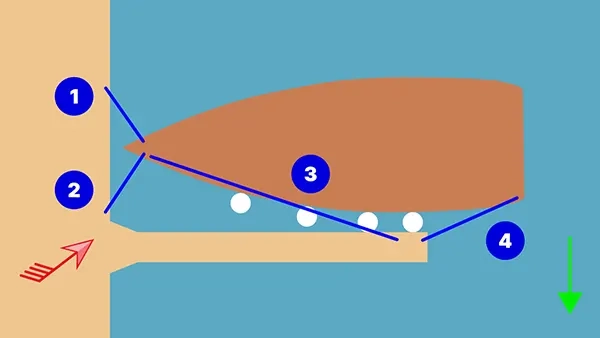Weekly quiz: casting off from a finger berth
You’re berthed to a finger dock. The wind is blowing (red arrow). You will then be proceeding between the docks towards the exit of the marina (green arrow).

Question of the day
🔹 In which order will you be casting off your dock lines 1, 2, 3, 4? Provide the ideal sequence.
And bonus questions
🔹 Now suppose the exit is in the other direction. Does that change things, and if so, how?
🔹 By the way, how are all of these docking lines called?
👉 Reply on one of our social media below. We’ll post the solution right here next Sunday!
Appreciating conditions for manoeuvring
Thanks to the many of you who have taken part in this quiz.
Because many factors come into play, there is no single right answer to this question. The type of boat you have, its manoeuvring ability, is the crew shorthanded or not, how wide the channel is, is there a neighbor to your starboardRight side of a boat when looking forward More or not: all of these are to be taken into account.
But let’s start with the weather first: only very few respondents actually noticed that the wind arrow was showing 40 knots of wind (10 knots per wind barb). That means if you don’t have to move, then don’t. You might even be doubling your lines rather than manoeuvring. But for the sake of argument, let’s say you do have to move and let’s learn.
Suggested manoeuvers
We will suggest two possible approaches:
🔹 If your boat has a fin keel, a strong a reliable reverse gear, and very little prop walk, then you might be better off exiting the marina in reverse. You will therefore be turning to port. In preparation, make sure 4 is long enough and runs through the dock cleat and comes back aboard so that you can use it to pivot. Also place some fenders on your starboardRight side of a boat when looking forward More bow. First letting go 1 should not produce any noticeable change since it should be slack. Then letting go 2 and putting in reverse should enable you to start moving aft. While doing this, give some slack onto 4 while you pull some of 3 back in. Once the bow has cleared any neighbor (or the adjoining finger), let 3 go and you’re good to steer hard to port, giving a tug on 4 if needed before finally releasing it too. Both the wind and prop walk will help you get the bow down anyways.
So, in summary : 1 – 2 – 3 – 4
🔹 If your boat has a long keel, or prop walk can be an issue, then you need to plan for an exit doing headway. Here again you will be letting 1 go early on. You can let go 4 next, especially if there is some room to starboardRight side of a boat when looking forward More. Then start reversing while steering to starboardRight side of a boat when looking forward More. Any shore hands walking along the finger with some tension on 2 would be of great help, otherwise just untie it. You now only have 3 left and keeping some tension on it as you back up will be crucial to keep your bow as close to the finger as possible. Along with 3 still being tied, windage should help your bow go across the wind. As soon as this is the case, let go 3 and steer straight and you should soon be able to clutch in forward gear, accounting for the stern moving to starboardRight side of a boat when looking forward More as you do.
Here, in summary : 1 – 4 – 2 – 3
Bear in mind that these are but propositions. Many different approaches have been suggested, and a great many of those are valid. It all depends on your own circumstances and experience.
Bonus questions
🔹 You’re now exiting up, which could make things more simple (once again giving allowance for various factors), because both types of boats will use the first approach above. You pretty much leave your finger in the same manner as the manoeuvrable boat above, and then you will simply exit the marina going forward.
🔹 To be clearer, it’s more useful to give these dock lines their proper names:
- 1 is the starboardRight side of a boat when looking forward More bow line or head line
- 2 is the port sideLeft side of a boat when looking forward More bow line or head line
- 3 is the bow spring or head spring
- 4 is the stern spring or aft spring or back spring. This one can be discussed, depending on where it’s tied on the boat and on the finger: if the line is mostly perpendicular to the boat, it might be a breast line, but on the diagram it clearly has a small angle to the boat’s axis, so it really acts as a spring.
Our next quiz on calculating tides is now live 👉 we’re awaiting your answer!
